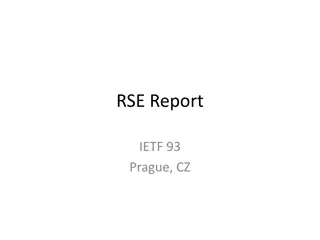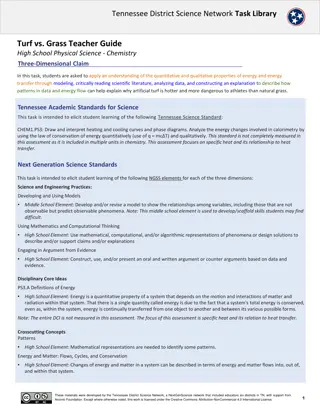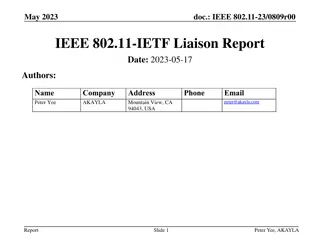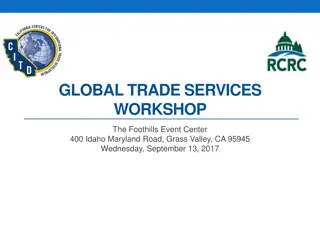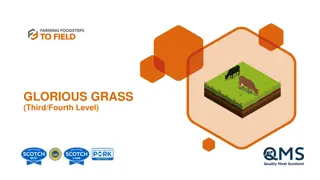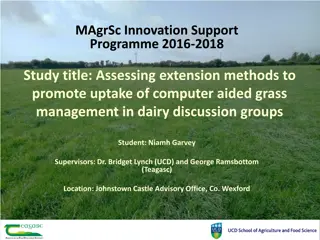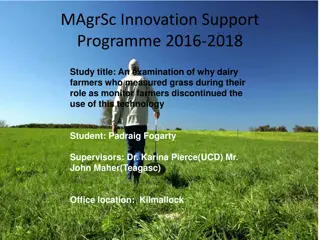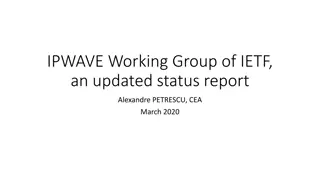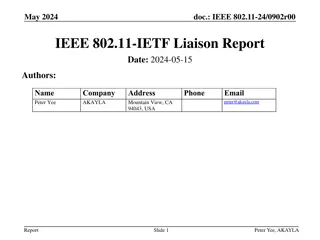The Magic of Watching Grass Grow at IETF Update
The highlights of IETF Update presentation by Cathy Aronson in Dallas, Texas featuring discussions on QUIC, IPv6, Hackerboards, and more. Learn about the informal IEPG gatherings and updates on IANA registry changes for IPv6 deployment surveys. Dive into the world of Internet standards and footwear styles at IETF.
Download Presentation

Please find below an Image/Link to download the presentation.
The content on the website is provided AS IS for your information and personal use only. It may not be sold, licensed, or shared on other websites without obtaining consent from the author.If you encounter any issues during the download, it is possible that the publisher has removed the file from their server.
You are allowed to download the files provided on this website for personal or commercial use, subject to the condition that they are used lawfully. All files are the property of their respective owners.
The content on the website is provided AS IS for your information and personal use only. It may not be sold, licensed, or shared on other websites without obtaining consent from the author.
E N D
Presentation Transcript
IETF Update The magic of watching grass grow CATHY ARONSON ARIN 38, DALLAS, TEXAS
About This Presentation This presentation is not an official IETF report There is no official IETF Liaison to ARIN or any RIR This is all my opinion and my view and I am not covering everything just highlights You should know I like funny quotes I hope you enjoy it Your feedback is greatly appreciated If you were there and have an interesting please share it! Opinions expressed are solely my own and I include thoughts that I typed while at the meeting.
Highlights A draft went all the way to RFC, RFC7788, and .home was never officially defined per RFC 6761 how to define special purpose domain names. QUIC BoF - Quick UDP Internet Connection QUIC is a new multiplexed and secure transport atop UDP, designed from the ground up and optimized for HTTP/2 semantics. While built with HTTP/2 as the primary application protocol, QUIC builds on decades of transport and security experience, and implements mechanisms that make it attractive as a modern general-purpose transport. Currently in Chromium Browser PLUS BoF - Path Layer UDP Substrate The PLUS working group's goal is to define a common shim layer atop the User Datagram Protocol (UDP) to provide a transport-independent method to signal flow semantics under transport and application control, necessary to enable the deployment of new, encrypted transport protocols within the existing Internet. I heard the same talk 3 times. Stay tuned for that! The IPv6 RFCs are not officially Internet Standards Ross Callon s talk about the cost of too many standards. Hackerboards..
IEPG What is it? The IEPG is an informal gathering that meets on the Sunday prior to IETF meetings. The intended theme of these meetings is essentially one of operational relevance in some form or fashion - although the chair will readily admit that he will run with an agenda of whatever is on offer at the time! The IEPG has a web page and a mailing list iepg@iepg.org - the usual subscription protocols apply.
IEPG IANA registry update Changes to IANA registry to help IETF Small tweaks IPv6 Deployment Survey 900 Responses 300 ISPs say v6 is a commercial service Charts of prefix sizes Questions about static prefixes
IEPG Measuring IPv6 ISP performance Is it reliable? Is it slower or faster than v4 These days most of the time unicast v6 results are similar than v4 44% v6 is faster Stats.labs.apnic.net DNSSEC Encryption algorithm ability Survey of DNSSEC going on out there.
IEPG What is an invalid ROA? ROA Misconceptions Only invalid if crypto chain fails. Nothing to do with BGP announcement. Yeti DNS Yeti DNS is a test bed so that folks can try new things coming in the root. Yeti tries different things IANA wants to implement, etc.
IEPG cryptech.is an effort to create an open hardware crypto engine design and the tools needed to make it trustworthy Pervasive monitoring is an attack DNS privacy implementation and deployment status Qname minimization just sends the info that is required RIPE Atlas Traceroute More work with RIPE atlas probes Real time traceroute stream available to all
The Presentation I saw 3 times https://tools.ietf.org/html/draft- bowbakova-rtgwg-enterprise-pa- multihoming-00 This document struggles with the age old problem of multi-homing with PA address space. This draft uses Source Address Dependent Routing (SADR) in the first hop routers.
Presentation I saw 3 times Here it is again.. Notes from Routing Area draft-bowbakova-rtgwg-enterprise-pa-multihoming holistic view .. not just router or host routing and how hosts choose right source address. send to the right ISP and also how to do policy.. using this ISP for A and another for B No NAT also failure scenarios how to pick the right source address Basically multiple scoped forwarding tables.
IPv6 Maintenance (6MAN) - ? The 6man working group is responsible for the maintenance, upkeep, and advancement of the IPv6 protocol specifications and addressing architecture. It is not chartered to develop major changes or additions to the IPv6 specifications. The working group will address protocol limitations/issues discovered during deployment and operation. It will also serve as a venue for discussing the proper location for working on IPv6- related issues within the IETF.
6Man IPv6 Specifications to Internet Standard, draft-ietf-6man-rfc2460bis , draft-ietf-6man-rfc4291bis , draft-ietf-6man-rfc1981bis We have been using IPv6 now for how long and the RFCs are not officially Internet Standards. lots of discussion of little bits of things that have been learned that need to be updated in these documents. This would allow us to move to Internet Standard sitting around for 60 seconds with half a packet is discouraging you have a spec therefore you care WG Last Call: Recommendation on Stable IPv6 Interface Identifiers, draft-ietf-6man-default-iids This generated a lot of discussion and impacts a number of drafts. They are asking for feedback Stages in the process to standard are here https://tools.ietf.org/html/rfc6410
6Man Other active individual drafts IANA IPv6 Special-Purpose Address Registry and unclear use of "global", and Special- Purpose IP Address Registries, draft- carpenter-6man-whats-global , draft-bchv- rfc6890bis Recommendation on Non-Stable IPv6 Interface Identifiers, draft-gont-6man-non- stable-iids
6Man Enterprise Multihoming using Provider- Assigned Addresses without Network Prefix Translation: Requirements and Solution, draft-bowbakova-rtgwg- enterprise-pa-multihoming
V6 Operations What is it? The IPv6 Operations Working Group (v6ops) develops guidelines for the operation of a shared IPv4/IPv6 Internet and provides operational guidance on how to deploy IPv6 into existing IPv4-only networks, as well as into new network installations. The main focus of the v6ops WG is to look at the immediate deployment issues; more advanced stages of deployment and transition are a lower priority. http://datatracker.ietf.org/wg/v6ops/
v6Ops draft-ietf-v6ops-unique-ipv6-prefix-per- host A prefix per host instead of an address per host. Benefits of a unique IPv6 prefix compared to a unique IPv6 address from the service provider are going from enhanced subscriber management to improved isolation between subscribers.
v6Ops 64::/16: An IPv4/IPv6 translation prefix 64::/16 for locally significant use with v4/v6 translation so folks doing this use their own address space. Using this isn t good because it s not unique Burning a /16 for this is insane .. so this is controversial to say the least. some folks think it s easier to do this out of different space.
Routing Area Open Meeting Highlight of the meeting from someone retiring Keep it Simple: The cost of (too many) Standards Ross Callon too much complexity and too many standards VPNs and encapsulations.. (example) IP in IP, IP in UDP, IP in GRE in IP, IP in GRE in UDP, L2TP; IPsec; MPLS in IP; MPLS in UDP .. if you have too many then you have no standards at all. Some vendors implement some and others others and then no one does the same thing. His perspective slide is good.. No one vendor
Routing Area Open Meeting CodeMatch Improved linkage between IETF Working Groups and developers (open source or proprietary), Assist with diversity with outreach to students, researchers, with some focus on regional diversity, Track implementations of drafts/RFCs to identify standards track candidates, Increased visibility into the relevance of standards and connections to open source efforts, etc
Routing Area Open Meeting draft-francois-rtgwg-segment-routing-ti-lfa & draft-francois-rtgwg-segment-routing-uloop Link failure and segment routing. Loop free rerouting draft-agv-rtgwg-spring-segment-routing-mrt User MRT for segment routing. IGP extensions are required to carry MRT. (Maximally Redundant Trees)
Routing Area Open Meeting draft-kumar-rtgwg-grpc-protocol draft-talwar-rtgwg-grpc-use-cases open source version of google s microservice communication network leverages standard HTTP/2 as its transport layer) use for streaming data and network configuration
Human Rights Considerations The Human Rights Protocol Considerations Research Group is chartered to research whether standards and protocols can enable, strengthen or threaten human rights, as defined in the Universal Declaration of Human Rights (UDHR) [1] and the International Covenant on Civil and Political Rights (ICCPR) [2], specifically, but not limited to the right to freedom of expression and the right to freedom of assembly.
Human Rights Considerations Laura DeNardis on Protocol Politics interesting talk on her book on governance and human rights on the Internet. Can use the architecture to subvert rights. Data localization, encryption backdoors, redirecting DNS queries, Raise questions about human rights. No longer just a communication network but also a control network (Internet of Things) .. other aspects of real human interactions. Will there be a lot of proprietary standards where we can no longer even look? Look up her books at Ourinternet.org
Human Rights Considerations UN Special Rapporteur Human Rights David Kaye on report 'Freedom of expression and the private sector in the digital age Freedom of expression.. standards.. Article 19. Provide the standards for the rights that all individuals enjoys. Opinion without interference. Right to seek and receive information of all kinds. regardless of media or frontiers. current project maps the was the private sector telecommunications companies, ISPs and equipment vendors. garbled by nature pressures on the tech community not to do the right thing. Lessons learned from RFC 6973 Privacy Considerations For Internet Protocols draft-tenoever-hrpc-research This is terminology and it s being used to look at other HRPC drafts and work.
IPv6 over Networks of Resource-constrained Nodes 6Lo 6lo focuses on the work that facilitates IPv6 connectivity over constrained node networks with the characteristics of: limited power, memory and processing resources hard upper bounds on state, code space and processing cycles optimization of energy and network bandwidth usage lack of some layer 2 services like complete device connectivity and broadcast/multicast
6Lo IPv6 over Bluetooth Low Energy Mesh Networks https://tools.ietf.org/html/draft-gomez-6lo- blemesh Transmission of IPv6 over MS/TP Networks https://tools.ietf.org/wg/6lo/draft-ietf-6lo-6lobac The building controls industry moving towards IPv6. Most numerous and least costly devices. if a lifetime is less than 1 second MS/TP - Master-Slave/Token-Passing
6LO ESC Dispatch Bytes and IANA Registry https://tools.ietf.org/wg/6lo/draft-ietf-6lo- dispatch-iana-registry Document to direct IANA on putting these in the registry 6lo ND backbone router https://tools.ietf.org/html/draft-ietf-6lo-backbone- router IPv6 over Near Field Communication https://tools.ietf.org/wg/6lo/draft-ietf-6lo-nfc
6Lo Designating 6LBR (6Lo Border Router) for IID Assignment https://tools.ietf.org/html/draft-rashid-6lo-iid-assignment This draft discusses how to designate 6LBR to assign IIDs for failed DAD. Currently, DAD cycle is repeated until the conceived IID isn't declared unique. To remove the overhead of repeated DAD cycle, this document enables 6LBR to suggest an IID (to 6LN) for failed DAD. It improves the overall network performance by avoiding repeated DAD cycle. To attain higher degree of privacy, IID can be periodical changed and designating 6LBR ensures the uniqueness of IID in a proactive manner.
6Lo Other drafts 6lo ETSI Plugfest@IETF96 An Update to 6LoWPAN ND https://tools.ietf.org/html/draft-thubert-6lo- rfc6775-update-00 Low-Power Wide Area Networks (LPWAN)
Dynamic Host Configuration - ? The DHC WG is responsible for defining DHCP protocol extensions. Definitions of new DHCP options that are delivered using standard mechanisms with documented semantics are not considered a protocol extension and thus are outside of scope for the DHC WG. Such options should be defined within their respective WGs and reviewed by DHCP experts in the Internet Area Directorate. However, if such options require protocol extensions or new semantics, the protocol extension work must be done in the DHC WG. charter-ietf-dhc-08
DHC Secure DHCPv6 and Secure DHCPv6 Deployment, draft-ietf- dhc-sedhcpv6 DHCPv6 includes no deployable security mechanism that can protect end-to-end communication between DHCP clients and servers. This memo describes a mechanism for using public key cryptography to provide such security. draft-li-dhc-secure-dhcpv6-deployment Secure DHCPv6 provides authentication and encryption mechanisms for DHCPv6. This draft analyses DHCPv6 threat model and provides guideline for secure DHCPv6 deployment. TOFU - Trust on First Use - tofu stores the host key and then use it in the future to verify the host
DHC Other Drafts draft-volz-dhc-relay-server-security draft-ietf-dhc-dhcpv6-failover-protocol draft-ietf-dhc-dhcpv6-yang draft-shen-dhc-client-port draft-ietf-dhc-rfc3315bis
OPSEC The OPSEC WG will document operational issues and best current practices with regard to network security. In particular, the working group will clarify the rationale of supporting current operational practice, addressing gaps in currently understood best practices and clarifying liabilities inherent in security practices where they exist. The scope of the OPSEC WG includes the protection and secure operation of the forwarding, control and management planes. Documentation of operational issues, revision of existing operational security practices documents and proposals for new approaches to operational challenges related to network security are in scope.
OPSEC The STRIDE towards IPv6: A Threat Model for IPv6 Transition Technologies, draft-georgescu-opsec-ipv6-trans-tech-threat- model-01 Created the STRIDE model (Spoofing, Tampering, Repudiation, Information Disclosure, Denial of service and Elevation of Privilege) Then looking at transition technologies with respect to this model. Recommendations on Filtering of IPv6 Packets Containing IPv6 Extension Headers Security and operational implications of extension headers. Operational advice on filtering them. How do we fix the widespread filtering?
OPSEC Operational Security Considerations for IPv6 Networks, draft-ietf-opsec-v6-09 Love this from the doc. IPv6 address allocations and overall architecture are an important part of securing IPv6. Initial designs, even if intended to be temporary, tend to last much longer than expected. Although initially IPv6 was thought to make renumbering easy, in practice, it may be extremely difficult to renumber without a good IP Addresses Management (IPAM) system. Re-addressing a network is hard.. Really?
SDN What is it? Software Defined Networking Early SDN models focused primarily on moving the control plane out of the network elements into controllers on the theory that the switching elements could remain simple, general-purpose, and cost-effective while at the same time allowing the control plane to rapidly evolve. A number of recent SDN models, on the other hand, include approaches in which control and data plane programability works in concert with existing and future distributed control planes. SDN aims to benefit all types of networks, including wireless, cellular, home, enterprise, data centers, and wide-area networks. The Software-Defined Networking Research Group (SDNRG) investigates SDN from various perspectives with the goal of identifying the approaches that can be defined, deployed and used in the near term as well identifying future research challenges. In particular, key areas of interest include solution scalability, abstractions, and programming languages and paradigms particularly useful in the context of SDN. In addition, it is an explicit goal of the SDNRG to provide a forum for researchers to investigate key and interesting problems in the Software-Defined Networking field. Finally, the SDNRG provides objective definitions, metrics and background research with the goal of providing this information as input to protocol, network, and service design to SDOs and other standards producing organizations such as the IETF, ETSI, ATIS, ITU-T, IEEE, ONF, MEF, and DMTF.
SDN Network operator Challenges for Commercial SDN Environments Speaker is from China mobile. tenant management and administration management information collection - tenants can see their own part of the network. Dynamically. each level monitored. end to end detection and precise fault location
SDN Techniques and tools for the management and operation of NFV and SDN networks NFV - Network Functions Visualization - life cycle of resources discuss a common set of abstraction models SDN Architecture and Use Cases for PCE-based Central Control PCE - Path Computation Element.. computes paths isolate computation from computing paths?
SDN Network Scheduling in Software-defined Environments Synchronized clocks on switches and then SDN tell them when to do what. coordinating updates or capturing snapshots update paths at a particular time timing is important so that re-routes don t cause congestion. TIMEFLIP - Time based TCAM look up
SDN Authentication and Authorization in Wired OpenFlow-based Networks using 802.1X SDN in campus networks Identity based network control Proof of concept so far in the lab. Limitations of Optimization for Multi-site NFV Network Service Delivery looks like moving stuff around using SDN to meet SLAs and optimizing CAPEX and OPEX sort of a survey of what s going on in this space SDN Controller Performance Evaluation looking at performance due to number of devices managed as well as the number of controllers.
SDN Others VNF Benchmark as a Service VNF vs. NFV VNF - refers to the implementation of a network function using software that is decoupled from the underlying hardware. NFV - refers to the overarching principle or concept of running software-defined network functions, independent of any specific hardware platform, as well as to a formal network virtualization initiative led by some of the world's biggest telecommunications network operators. The abstract art of composing SDN applications Control as a minimal common denominator for future networking
INTAREA What is it? The Internet Area Working Group (INTAREA WG) acts primarily as a forum for discussing far-ranging topics that affect the entire area. Such topics include, for instance, address space issues, basic IP layer functionality, and architectural questions. The group also serves as a forum to distribute information about ongoing activities in the area, create a shared understanding of the challenges and goals for the area, and to enable coordination.
INTAREA IAB Stack Evolution Program stackevo-discuss@iab.org sounds interesting. Plus bof was part of this GUE and Extensions Okay so this is yet another encapsulation protocol. In light of Ross Callon s talk this guy was asked simply, why ?
INTAREA Other topics IP Broadcast Considerations IP Encapsulation Congestion Notification Guidelines Extended Ping can t ping if unnumbered or private addresses or link-local Eping allows you to ping these interfaces. changes to ICMP Bandwidth Aggregation for Internet Access how to bond two connections to the same ISP like in the case of homenet.. IP over intentionally partially partitioned links Ad Hoc Wireless Networks Multiple Access Management IPIPv4 Tunnel Yang Model
HOMENET What is it? The purpose of this working group is to focus on this evolution, in particular as it addresses the introduction of IPv6, by developing an architecture addressing this full scope of requirements: prefix configuration for routers managing routing name resolution service discovery network security charter-ietf-homenet-03
HOMENET HNCP Deployment Experiences HNCP is the address configuration protocol of the HOMENET protocol suite. HNCP is designed to configure unmanaged, small, stable, prefix-based networks. Architecture Draft draft-lemon-homenet-naming-architecture-01 Users cannot be assumed to be skilled or knowledgeable in name service operation, or even to have any sort of mental model of how these functions work
HOMENET This draft is all about DNCP and HNCP Distributed Node Consensus Protocol Homenet Networking Control Protocol. draft-ietf-homenet-hncp-bis-00 This is all about how a homenet figures itself out. Super hard problem to solve Discussion of RFC7788. What should be done about .home ?
HOMENET Documents Published since last meeting RFC 7787 - Distributed Node Consensus Protocol RFC 7788 - Home Networking Control Protocol New draft Babel for homenet draft-ietf-homenet-babel-profile-00
HOMENET Other drafts draft-ietf-homenet-hybrid-proxy-zeroconf- 02 draft-ietf-homenet-front-end-naming- delegation-04 draft-ietf-homenet-naming-architecture- dhc-options-03












